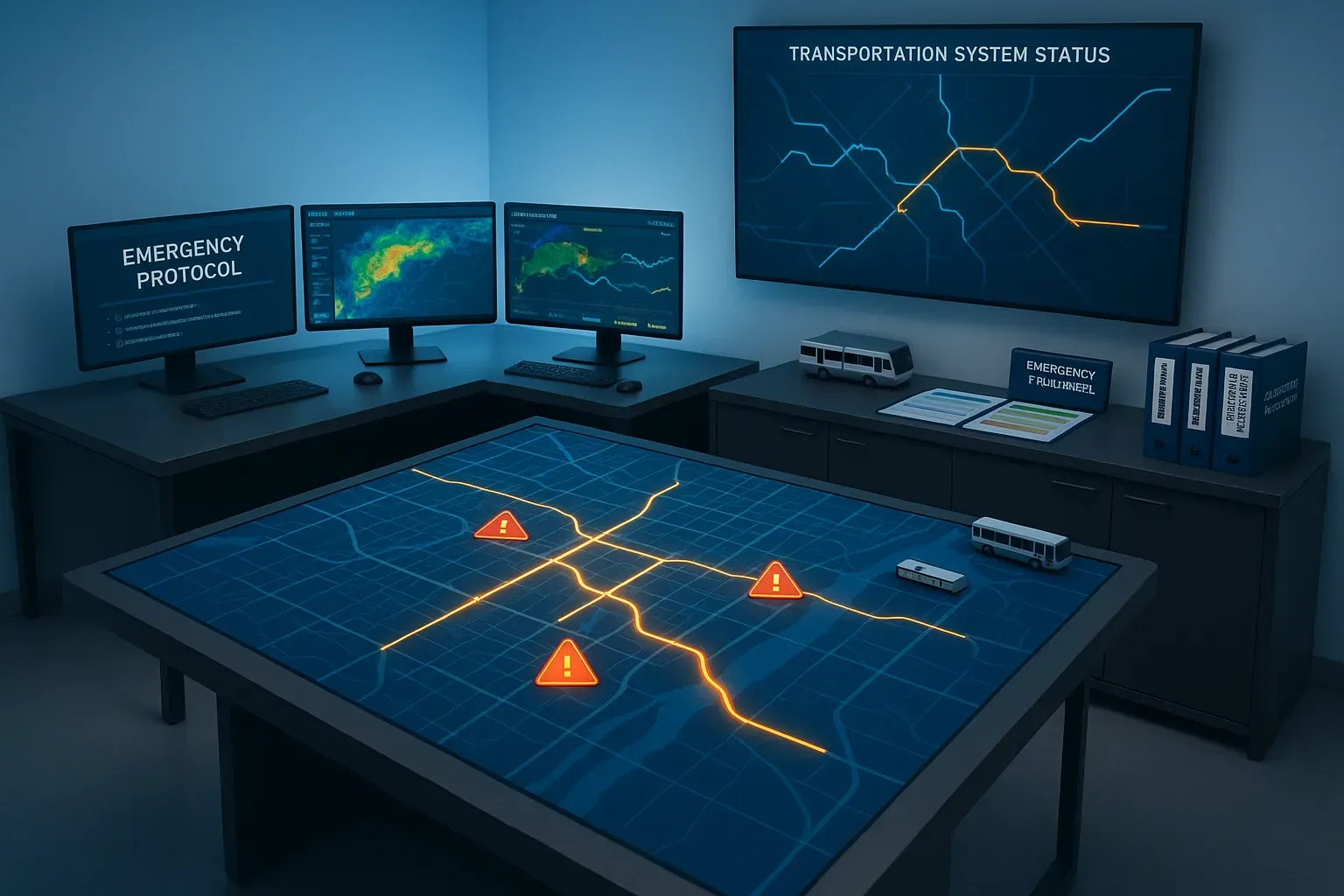Transit agencies face critical decisions when preparing for emergencies that can impact thousands of passengers. This article explores essential strategies for emergency preparedness, including redundant communication systems and effective preplanning, based on insights from industry experts. Understanding the balance between structured preparation and adaptive response capabilities could make the difference when crisis situations arise.
- Build Redundant Communication Systems for Passenger Safety
- Combine Preplanning with Flexibility for Crisis Response
- Plan Communication and Backup Systems Before Emergencies
- Create Community Partnerships for Emergency Support
- Conduct Realistic Cross-Departmental Emergency Simulations
- Implement Multilayered Emergency Communication Infrastructure
- Empower Staff with Clear Emergency Decision Authority
- Establish Flexible Resource Allocation Protocols
Build Redundant Communication Systems for Passenger Safety
As an example, disaster preparedness for transit systems would involve redundant communication paths that are capable of operation if the primary path does not work, providing reliable information to passengers when the infrastructure is damaged or the network is impaired. From my professional life in transportation logistics, I feel that good responses depend on existing communication tools such as SMS alerts, mobile apps, social media, and signage or staff communications. These ensure continuous passenger information.
The fact that staff help take decisions on the spot and do not have to wait for top-down approvals in an emergency is part of passenger safety. This includes pre-positioning emergency supplies and establishing relationships to evacuate special needs passengers.
In terms of transport across countries, effective emergency management is exemplified by continuous investment in reliable backup ICT systems and regular staff training with practical adversarial scenarios. Communicating openly in emergencies builds trust through real-time updates and alternative possibilities, pushing back against overly rosy stories that can deceive. Critical points are redundancy in the communication infrastructure, contracts with backup transporters, and blind navigation systems that also work without electrical power or network access.
In other words, emergency preparedness is not an expensive investment in sound technologies and systems; it is a cheap insurance policy against accidents and failures of those new technologies and systems. Its focus needs to be on the communication system(s) that will restore our normal effective use of those very complex technologies.

Combine Preplanning with Flexibility for Crisis Response
Transit operators can better prepare for emergencies by combining proactive PREPLANNING with real-time FLEXIBILITY. All good plans begin with scenario mapping—speculating on potential disruptions (road closings, severe weather, infrastructure shutdowns, and security threats) and listing proposed responses. Strong communication between operations, law enforcement, and emergency management teams ensures that communications don’t break down during rapid decision making. Agencies should also spare no expense on redundancy: backup power, communication systems, and staff cross-training to ensure that an agency can still perform its most critical functions even under pressure.
One model that worked was Washington D.C.’s Metro system, which developed a comprehensive emergency management plan after years of disaster drills involving police and fire departments. One Friday night, when a massive power failure hit part of the network once again, that agency put its continuity plan into effect within minutes — shuttles in service, riders advised by automatic alert systems, and coordination maintained throughout all of the departments. The aim is not to avoid disruption but to control it in a way that protects public safety, gets service running again as soon as possible, and maintains the confidence of the traveling public.

Plan Communication and Backup Systems Before Emergencies
Emergency planning begins with communication. You cannot mobilize during a mess if you did not plan during peace. We, at our business, set up a continuity model where each team member has a backup and all critical files are replicated in a cloud service. When a local blackout struck, we recovered operations during a sixty-minute window because each person knew what to do anyway.
Transit agencies can profit by having a similar structure. Develop parallel lines of communication and ensure each individual knows their responsibility during a disruption. Technology aids recovery, but planning guarantees it.

Create Community Partnerships for Emergency Support
Building relationships with neighborhood groups, disability advocates, and community organizations creates vital support networks that can activate during emergencies. These community connections help transit agencies understand the unique needs of different passenger populations and develop appropriate assistance plans before crises occur. Local partners can provide volunteer support, temporary shelter spaces, and language assistance when regular transit operations become disrupted.
Community-based networks often reach vulnerable individuals more effectively than official channels during emergencies because they have established trust. Transit agencies gain valuable local knowledge through these partnerships while community organizations become better prepared to help their members during transportation disruptions. Transit planners should reach out to community organizations today to begin building these essential emergency support relationships.
Conduct Realistic Cross-Departmental Emergency Simulations
Emergency simulations that bring together operators, maintenance teams, security personnel, and administration staff create muscle memory for crisis response. These regular practice sessions reveal communication gaps and procedural weaknesses that might otherwise remain hidden until a real emergency occurs. Cross-departmental training ensures that staff members understand their roles clearly and can step into alternative positions if needed during a crisis.
Transit agencies benefit most from unannounced drills that test genuine readiness rather than scripted scenarios where everyone knows what will happen next. Realistic simulations should include community partners like police, fire departments, and medical services to strengthen coordination between organizations. Transit leadership teams should schedule comprehensive emergency drills immediately to identify and address current vulnerabilities.
Implement Multilayered Emergency Communication Infrastructure
Transit agencies should implement backup radio systems, digital platforms, and emergency broadcast capabilities that function even when main systems fail. These multi-layered communication tools enable staff to stay connected with each other and provide real-time updates to passengers during crises. Communication infrastructure must include both high-tech solutions and low-tech backups like bullhorns and printed emergency instructions in multiple languages.
The most effective emergency response begins with clear information flow between all parties involved in a crisis situation. Transit officials should consider how messages will reach vulnerable populations who may not have access to smartphones or understand the primary language used for announcements. Every transit agency must evaluate and upgrade their communication systems before disaster strikes.
Empower Staff with Clear Emergency Decision Authority
Decision-making bottlenecks during emergencies can cost lives, making it essential for transit agencies to empower employees at all levels to take appropriate action without waiting for approval chains. Staff-wide authority protocols clearly define which decisions can be made by frontline workers versus which require management input during crisis situations. These decision frameworks provide guidance while allowing workers to use their judgment when standard procedures cannot address unique emergency circumstances.
Transit agencies benefit from training all employees to recognize emergency thresholds and understand their authority to act when passenger safety is at risk. Decision protocols should include clear communication requirements so actions taken independently are properly documented and shared with the response team. Transit leadership must review their current decision-making structures and implement more responsive protocols before the next emergency situation occurs.
Establish Flexible Resource Allocation Protocols
Flexible resource allocation allows transit agencies to quickly redistribute vehicles, personnel, and supplies to areas with the greatest need during crises. This adaptability requires maintaining reserve fleets, cross-training employees, and establishing emergency supply caches at strategic locations throughout the service area. Transit systems with flexible operations can swiftly convert regular routes into emergency evacuation services or medical transport when needed during disasters.
Resource flexibility depends on having clear policies about when and how to shift from normal operations to emergency response modes without lengthy approval processes. Transit managers should develop clear procedures for reallocating resources during different types of emergencies and ensure all staff understand these protocols through regular review sessions. Transit agencies should examine their current resource allocation systems today to identify and remove potential bottlenecks.








